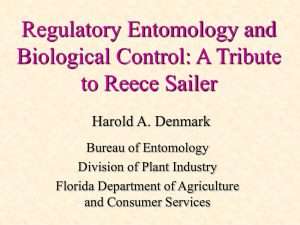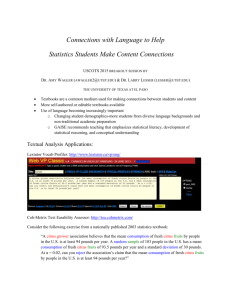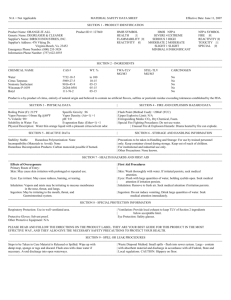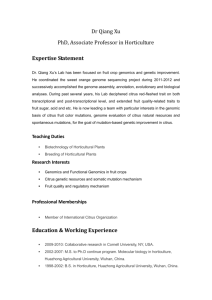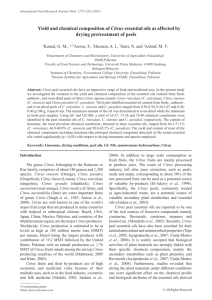EST2
advertisement
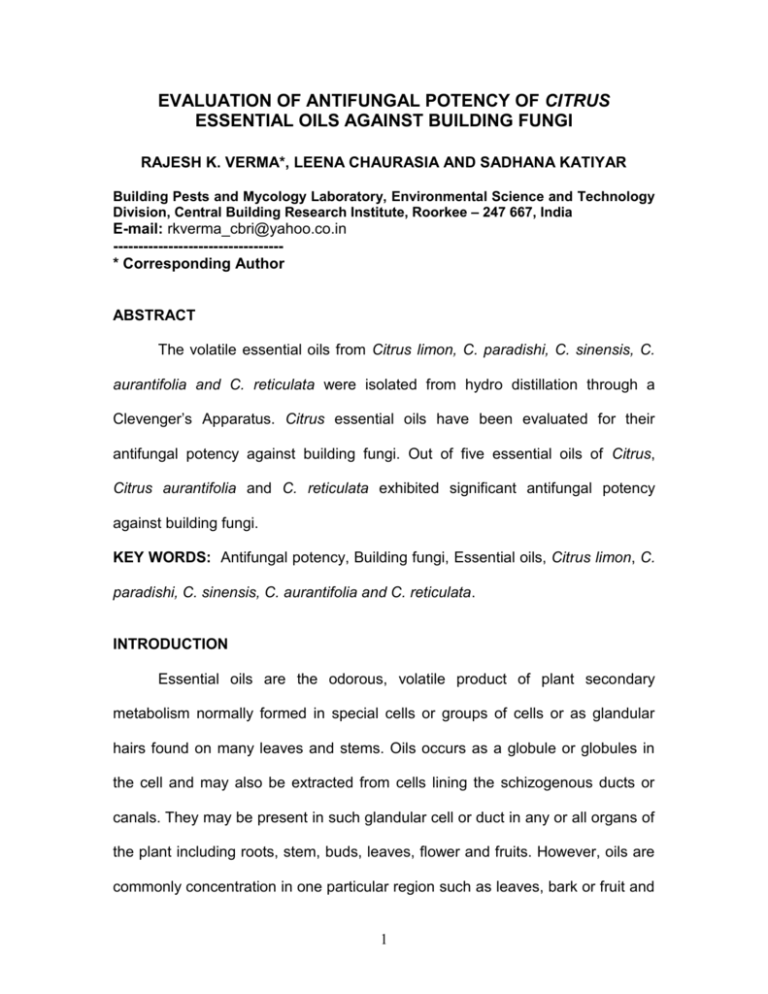
EVALUATION OF ANTIFUNGAL POTENCY OF CITRUS ESSENTIAL OILS AGAINST BUILDING FUNGI RAJESH K. VERMA*, LEENA CHAURASIA AND SADHANA KATIYAR Building Pests and Mycology Laboratory, Environmental Science and Technology Division, Central Building Research Institute, Roorkee – 247 667, India E-mail: rkverma_cbri@yahoo.co.in ---------------------------------* Corresponding Author ABSTRACT The volatile essential oils from Citrus limon, C. paradishi, C. sinensis, C. aurantifolia and C. reticulata were isolated from hydro distillation through a Clevenger’s Apparatus. Citrus essential oils have been evaluated for their antifungal potency against building fungi. Out of five essential oils of Citrus, Citrus aurantifolia and C. reticulata exhibited significant antifungal potency against building fungi. KEY WORDS: Antifungal potency, Building fungi, Essential oils, Citrus limon, C. paradishi, C. sinensis, C. aurantifolia and C. reticulata. INTRODUCTION Essential oils are the odorous, volatile product of plant secondary metabolism normally formed in special cells or groups of cells or as glandular hairs found on many leaves and stems. Oils occurs as a globule or globules in the cell and may also be extracted from cells lining the schizogenous ducts or canals. They may be present in such glandular cell or duct in any or all organs of the plant including roots, stem, buds, leaves, flower and fruits. However, oils are commonly concentration in one particular region such as leaves, bark or fruit and 1 when occurring in various organs in one plant may process different individual chemical components (Bonner, 1991). The higher plants contain essential oil constituted with the secondary metabolism such as alkaloids, terpenoids, phenolices, and minor chemicals, which are believed to be synthesized primarily as a chemical defense against harmful insects, bacteria and fungi and even vertebrate, herbivores (Tsao and Coats, 1995 and Tsao et al., 1995). Essential oil of some higher plant has recently proved successful in providing effective control of storage losses by several pests. These compound were non phytotoxic and easily biodegradable. Potentialities of some of the essential oils against fungal diseases of some agricultural crops, stored fruits, vegetables and food commodities have also been demonstrated (Arora and Pandey, 1977; Dikshit et al., 1983; Dubey et al., 1983; Tiwari et al., 1988; Asthana et al., 1989; Deena and Thoppil et al., 2000; Cai et al., 2002; Guynot et al., 2003; Kumbhar et al., 2004; Benkeblia, 2004). In the present investigation, essential oil of Citrus limon, C. paradishi, C. sinensis, C. aurantifolia and C. reticulata were isolated through a Clevenger’s apparatus and evaluated for their fungi toxic activity against Aspergillus niger, a building fungi. MAETRIALS AND METHODS The aboriginal plants viz. Citrus limon, C. paradishi, C. sinensis, C. aurantifolia and C. reticulata, were brought to the laboratory and their oil was isolated with the help of Clevenger’s Apparatus (Clevenger, 1928) using water as solvent. The isolated volatile fraction showed two distinct layers. An upper oily 2 layer and lower aqueous layer both the layers were separated and the moisture from the oily layer were removed by adding anhydrous sodium sulphate. Minimum inhibition concentration (MIC) The building fungi, Aspergillus niger has been maintained in our laboratory. Prior to evaluation, essential oils were diluted with acetone to desired concentration. The fungi toxicity of the essential oil was evaluated by the poisoned food technique (Grover and Moore, 1962; Pandey et al., 1982; Verma and Chaurasia, 2005). The experiment was performed in triplicate. RESULTS AND DISCUSSION The colony diameter (mm) of Aspergillus niger growing on potato dextrose agar exposed to essential oils of Citrus limon, C. paradishi, C. sinensis, C. aurantifolia and C. reticulata after 72 hours of incubation at 28oC has been presented in Table –1. All Citrus essential oils exhibited fungi toxicity as compared to control. The essential oil of Citrus aurantifolia and C. reticulata exhibited the highest antifungal potency (MIC) at 100 ppm of concentration after 72 hours of incubation (28oC) against Aspergillus niger. However, essential oils of Citrus limon and C. paradishi exhibited moderate fungi toxic potency (MIC) at 200 ppm and the essential oil of C. sinensis exhibited least antifungal potency. The MIC of essential oil of C. sinensis was observed at 300 ppm. The fungi toxicity may be due to the presence of monoterpenes, oxygenated monoterpenes, sesqiterpenes, aliphatic alcohol; aliphatic aldehyde, esters, ketones and other chemical components in evaluated Citrus essential oils. 3 CONCLUSION From the foregoing it is apparent that among five essential oils of Citrus, two essential oil viz., Citrus auantifolia and C. reticualta have promising antifungal potency against building fungi. The present study will be helpful in the realistic approach for the development and formulation of eco- friendly fungicide and thus in the effective fungi management using natural products. 4 Table-1 Mean colony diameter (mm) of Aspergillus niger growing on potato dextrose agar to different essential oils and concentration after 72 hours of incubation at 28oC. Essential oil Concentration (ppm) 50 100 200 300 400 500 Control 90.0 90.0 90.0 90.0 90.0 90.0 Citrus limon 20.6 13.0 * Citrus paradishi 8.3 6.3 * Citrus sinensis 19.6 16.0 5.3 Citrus aurantifolia 9.3 * Citrus reticulata 8.6 * *MIC – Minimum inhibition concentration 5 * BIBLIOGRAPHY Arora, R. and Pandey, G. N. 1977. The application of essential oil and their isolates for blue mold decay control in Citrus reticulata. J. Food. Sci. Technol.14: 14-16. Asthana, A., Dixit, K., Tripathi, N.N. and Dixit, S. N. 1989. Efficacy of Ocimum oil against fungi attaching chilli seed during storage. Trop. Sci. 29: 15-20. Benkeblia, N. 2004. Antimicrobial activity of essential oils extracts of various onions (Allium cepa) and garlic (Allium sativum). Lebensm.-Wiss.u.-Technol. 37: 263-268. Bonner, J. 1991. Biogenesis of Natural Compounds ed Bernfield, P. p. 241. Pergamon Press. Cai, Y., Jiang, J.G., Liu, C. H., Kong, L. D. and Tan, R. X. 2002. Composition and antifungal activity of oil from Perilla frutescens leaves. Intern. Pest Control. 44: 66-68. Clevenger, J. F. 1948. Apparatus for the determination of volatile oil. Pharma. Assoc. 17: 346. Deena, M. J. and Thoppil, J. E. 2000. Antimicrobial activity of the essential oil of Lantana camara. Fitoterapia. 71: 453-455. Dikshit, A., Dubey, N. K., Tripathi N. N. and Dixit S. N. 1983. Cedrus oil-A promising storage fungi toxicant. J. Stored. Prod. Res. 19: 159-162. Dubey, N. K., Bhargava and Dixit S.N. 1983. Protection of some stored food commodities from fungi by essential oils of Ocimum canum and Citrus medica. Intern. J. Trop. Plant Dis. 1: 177-179. Grover, R. K. and Moore, J. D. 1962. Toximetric studies of fungicides against brown rot organism, Sclerotinia fructicola and S. laxa. Phytopathol. 52: 876-880. Guynot, M. E., Ramos, A. J., Seto, L., Purroy, P., Sanchis, V. and Marin, S. 2003. Antifungal activity of volatile compounds generated by essential oils against fungi commonly causing deterioration of bakery products. J. App. Microbiol. 94: 893-899. 6 Kumbhar, P. P., Chavan, K. M., Patil, U. B., Nikumbh, V. P., Bendre, R. S. and Dewang, P. M. 2001. Antifungal and repellent potency of some spice extracts. Pestology 8: 44-46. Pandey, D. K., Chandra, H. and Tripathi, N. N. 1982. Volatile fungi toxic activity in higher plants with special reference to that of Callistemon lanceolatus DC. Phytopathl. Z. 105: 175-182. Taso, R. and Coats, J. R. 1995. Starting from nature to make better insecticides. Chemtech. 25: 23-38. Taso, T., Lee, S., Rice, P. J. and Coats, J. R. 1995. Monoterpenoids and their synthetic derivatives as leads for new insect control agents. In “Synthesis and Chemistry of Agrochemicals IV”, Ed. By Baker, D., Fenyes, J. and Basarab, G.S. ACS Symposium series 548; American Chemical Society, Washington DC. Chapter-28, pp.321-324. Tiwari, R., Mishra, D. N. and Upadhyaya P. S. 1988. Efficacy of some plant volatiles for the control of black mould of onion caused by Aspergillus niger Van Tiegh during storage. Natn. Acad. Sci. Lett. 11: 345-347. Verma, R. K. and Chaurasia, L. 2005. Synthesis and antifungal studies of some novel pyrazolopyridine derivatives. J. Indian Chem. Soc. 82: 665-669. 7


